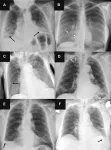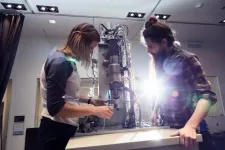(Press-News.org) (Santa Barbara, Calif.) — What makes for a successful climate-resilient fishery, one that sustainably produces resources for human benefit despite increasing climate stressors and human impacts? It’s a question that faces present and future fisheries, their practitioners and fishing communities as the world turns to the ocean to feed its growing population.
“For a fishery to be resilient it needs to be able to prepare for, resist, cope with, recover from, or adapt to any given impact,” said Jacob Eurich, who is a research associate at UC Santa Barbara’s Marine Science Institute, and a fisheries scientist at the Environmental Defense Fund (EDF). “In most cases a fishery will need to have a combination of these capacities to continue to produce food, income and well-being to the people who rely on them.”
It’s not a one-size-fits-all situation, according to Eurich, who led an international cohort of researchers for a paper published in the journal Fish and Fisheries. Because fisheries are complex marine ecosystems that face unique combinations of circumstances across the globe, achieving climate resilience will require equally diverse strategies, he said.
Fortunately, there are climate resilience success stories to draw lessons from. To gain these valuable insights, Eurich and colleagues examined 18 fisheries that expand our knowledge about how resilience operates across the world. They tested these fisheries’ resilience attributes to learn how and why they were able to persist despite climate change and human impact and, importantly, for whose benefit. The researchers then synthesized their findings into fishery archetypes and resilience pathways for other fishery practitioners that aspire to increase levels of resilience and sustainable benefits to society.
Diverse fisheries, diverse strategies
For a fishery to be successful in the face of climate change, it must be effective across ecological, social and governance dimensions — that is, be able to not only support the health and productivity of its resources but also be supported to that end in its operations and its role in society.
“The biggest challenge is that every fishery is different,” Eurich said. “Each fishery has different characteristics and operates on different scales, for different reasons and with unique goals.” The survey conducted by the research team — from the Science for Nature and People Partnership (SNAPP) Climate Resilient Fisheries Working Group, which was led by the Gulf of Maine Research Institute (GMRI), Cornell University and EDF and convened at UCSB’s National Center for Ecological Analysis & Synthesis (NCEAS) — provided the data for a framework that standardized, prioritized and scored 38 attributes of fisheries and their milieu. This system allowed the researchers to find strengths and commonalities to which other fisheries under similar circumstances may align to increase their own resilience.
Pathways to resilience
The researchers developed five archetypes of climate-resilient fisheries and detailed two pathways to climate resilience. They found that in some fisheries, climate resilience is derived from strong ecological assets and tight-knit communities that promote flexible governance, despite having limited economic avenues outside of fishing. In these fisheries, the non-monetary benefits of fish, such as nutrition and culture, are distributed broadly. However, the shift to globalized economies can disrupt this model.
In other fisheries, robust governance and economic assets drive the efficient conversion of fish into economic benefits. Competition, coupled with access to knowledge and capital for investment, can spur technological advancement, which often results in responsive governance. However, in these fisheries, wealth might become concentrated among the most successful firms, leading to power imbalances and enabling only a select group to withstand losses or capitalize on new economic opportunities posed by climate change.
“We also identified key priority areas, where a deficiency in certain attributes hindered fishery resilience,” Eurich added. “Often, fishery practitioners know the climate-ready management interventions needed in their system but political obstacles and a lack of support or capacity block these changes. By taking the time to identify and enhance inhibiting attributes, practitioners can increase the success of long-term interventions.”
Next steps
Lily Zhao, a Ph.D. student in the UCSB’s Department of Ecology, Evolution and Marine Biology, who co-led the piece, added that “There's still a lot of work to be done to ensure sources of resilience are distributed equitably to support climate adaptation within fishery systems, so I'm excited to see how priority areas we found like equitable and inclusive governance will be built and emphasized in the coming decades”.
The framework for assessing fishery resilience and research findings have also been converted to an interactive decision support tool. The Climate-Resilient Fisheries Planning Tool guides users through a six-step process that will provide key elements needed to develop a fishery resilience plan.
END
Researchers build and test a framework for achieving climate resilience across diverse fisheries
2023-09-26
ELSE PRESS RELEASES FROM THIS DATE:
Radiologists outperformed AI in identifying lung diseases on chest X-ray
2023-09-26
OAK BROOK, Ill. – In a study of more than 2,000 chest X-rays, radiologists outperformed AI in accurately identifying the presence and absence of three common lung diseases, according to a study published in Radiology, a journal of the Radiological Society of North America (RSNA).
“Chest radiography is a common diagnostic tool, but significant training and experience is required to interpret exams correctly,” said lead researcher Louis L. Plesner, M.D., resident radiologist and Ph.D. fellow in the Department of Radiology at Herlev and Gentofte Hospital in Copenhagen, Denmark.
While commercially available ...
SwRI, UTSA collaborate to detect traumatic brain injury through breath analysis
2023-09-26
SAN ANTONIO — September 26, 2023—Researchers from Southwest Research Institute (SwRI) and The University of Texas at San Antonio (UTSA) are developing techniques to detect traumatic brain injury (TBI) by analyzing breath for specific biomarkers. The project, led by SwRI’s Dr. Mark Libardoni and UTSA’s Dr. Marzieh Memar and Dr. Morteza Seidi, is supported by a $125,000 grant from the Connecting through Research Partnerships (Connect) program.
Breath analysis is performed by analyzing exhaled breath for specific biomarkers, such as metabolites, proteins and ...
Projects launch to map brain connections in mouse and macaque
2023-09-26
A complete map of all the connections in an entire mammalian brain may be in sight. Allen Institute researchers have just launched three new projects to construct large, detailed maps of neuronal connections in sections of the mouse and macaque brains, with an eye toward creating full wiring diagrams of these animals’ brains in the future. These projects are funded by the National Institutes of Health’s Brain Research Through Advancing Innovative Neurotechnologies® (BRAIN) Initiative.
Allen Institute research teams ...
National Science Foundation research award will expand the shift+OPEN initiative from the MIT Press
2023-09-26
The MIT Press is delighted to announce that it has received a two-year, $275,000 Early-Concept Grant for Exploratory Research (EAGER) from the National Science Foundation to expand the shift+OPEN initiative and shift at least two more journals to diamond open access. The Press will also use the grant to assess and compare the viability of open access models for advancing and sustaining the outputs of scientific and scholarly STEM and HSS research.
“We’re grateful to the National Science Foundation for their support of our growing shift+OPEN program,” says Nick Lindsay, Director for Journals and Open Access for the MIT ...
New report shows Food is Medicine interventions would save U.S. lives and billions of dollars
2023-09-26
Incorporating targeted food and nutrition strategies into healthcare on a national level will improve health and quality of life, reduce work for hospitals, and cut healthcare costs, according to experts studying Food is Medicine (FIM) efforts. The health and economic benefits of this approach are detailed in a report out today from researchers at the Food is Medicine Institute at the Friedman School of Nutrition Science and Policy at Tufts University, through support from The Rockefeller Foundation.
The True Cost of Food: Food is Medicine Case Study quantifies the potential health and economic benefits of FIM efforts, which refer to food-based nutrition ...
The Giant Magellan Telescope’s final mirror fabrication begins
2023-09-26
PASADENA, CA — September 26, 2023 — The Giant Magellan Telescope begins the four-year process to fabricate and polish its seventh and final primary mirror, the last required to complete the telescope’s 368 square meter light collecting surface, the world’s largest and most challenging optics ever produced. Together, the mirrors will collect more light than any other telescope in existence, allowing humanity to unlock the secrets of the Universe by providing detailed chemical analyses of celestial objects and their origin.
Last week, the University of Arizona Richard F. Caris Mirror Lab closed the lid on nearly 20 tons of the ...
Fabrication of p-type 2D single-crystalline transistor arrays with Fermi-level-tuned van der Waals semimetal electrodes
2023-09-26
Professor Soon-Yong Kwon in the Department of Materials Science and Engineering and the Graduate School of Semiconductor Materials and Devices Engineering at UNIST, in collaboration with Professor Zonghoon Lee, has embarked on a pioneering research endeavor focusing on the development of high-performance p-type semiconductor devices, utilizing molybdenum ditelluride (MoTe2)—a compound renowned for its unique properties. This pioneering technology holds great promise for application in the next-generation complementary metal oxide semiconductor (CMOS) industry, where ultrafine technology is crucial.
CMOS ...
Tailored text messages not enough to improve mobility after heart issues
2023-09-26
Nearly one in three Americans wear a wearable device, like a smartwatch, to track their health and fitness.
Studies have shown positive effects of increasing movement in ways that can be measured by these devices, especially for people who recently had a heart attack or other cardiovascular event.
But a Michigan Medicine-led report shows that adding a mobile health application to such devices yields mixed results. Tailored text messages to encourage high-risk people to move more may improve some short-term outcomes but doesn’t always improve physical activity levels for everyone.
The ...
The ethics of accepting tainted donations
2023-09-26
A study digs into a topical debate: should institutions accept donations from bad people? Jeffrey Epstein donated to MIT after he was a convicted sex offender. The Sackler family donated to museums around the world, which had to decide whether to keep their names on display and whether to continue accepting funds after the family faced widespread criticism and legal consequences for pushing addictive painkillers on the public. Ethicists are often split on whether organizations should take money from morally tainted donors. The money can support good outcomes in the world, but the reputation of the organization may suffer and the public ...
Yoga improves quality of life, cardiovascular function in heart failure patients
2023-09-26
Previous studies have shown that yoga therapy and lifestyle modifications have improved heart failure patients’ quality of life and enhanced their cardiovascular function. A new study, presented at the American College of Cardiology Asia 2023 conference, examines the long-term outcomes of yoga therapy to determine the benefit of adding yoga therapy as a complementary treatment in the management of heart failure.
Heart failure is a form of cardiovascular disease where the heart muscle is either too weak or too stiff to pump properly, often leading to fluid buildup, shortness of breath and other complications. ...








